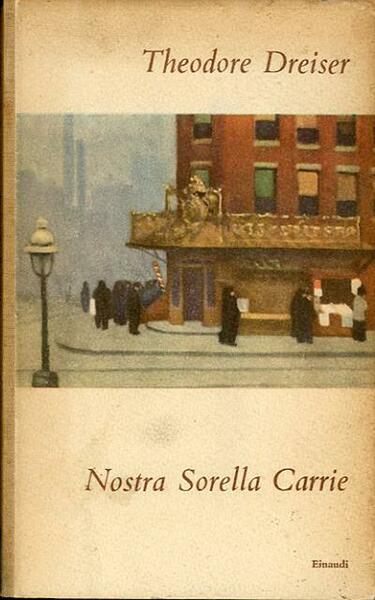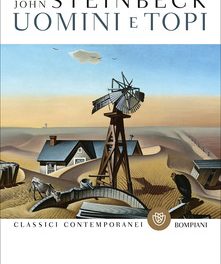Il romanzo è l’emblema della lotta tra la povertà e la ricchezza, lotta vissuta sulla pelle dell’autore per tutta la vita. Egli concepì un odio profondo per la povertà e un’ammirazione grande per il mondo dei ricchi e dei potenti da imporsi di “non dover essere mai tra i miseri”. Questo divenne il motivo fondamentale ed il tema portante della sua narrativa. Agosto 1889. Carrie parte dal piccolo villaggio di Columbia, Wisconsin e va a Chicago a trovare un lavoro in realtà sfuggire alla miseria del suo paese, della gente, della vita sempre uguale senza prospettive. Parte con “pochi soldi,due vestiti, un paio di scarpe, un cappellino” e va a stare presso la sorella sposata che subito le dice che deve mettersi alla ricerca di un’occupazione che risulta difficile; la giovane, sostenuta da una grande voglia di non mollare, ritrova lo stesso signore che aveva incontrato nel treno, il signor Drouet “il prototipo del rappresentante di case industriali”, il quale prende a cuore la sua rstoria e si offre di aiutarla. Ma C., donna di stretta fede puritana, non vuol accettare la sua disponibilità, ma davanti agli ostacoli e ormai finiti i risparmi, decide di stringere l’amicizia fino ad andare a stare da lui! D. la introduce in ambienti ricchi, i migliori ristoranti e persino a teatro! Ad una cena è presentata al Signor Hurstwood, un uomo elegante, prestante, soprattutto ricco. Una nuova svolta della vita! L’uomo s’innamora follemente di lei e In breve tempo la convince ad andare a stare da lui; durante l’assenza del Drouet, C. raccoglie le sue cose e va in un appartamento di cui lui dispone. Ora lei spera nel matrimonio che non arriva mai! H. le presenta il meglio della vita sociale e soddisfa le esigenze artistiche di C. che presto si fa notare in particine teatrali più grandi fino a cantare e ballare. Il loro tenore di vita diventa pesante tra vestiti, ristoranti e bel mondo e i debiti aumentano. Per fronteggiare i creditori H. ruba l’ammontare dalla cassaforte della sua società, ma il furto è subito scoperto ed in breve sono denunciati. Fanno in tempo a fuggire spostandosi tra gli Stati per non farsi acchiappare. H., finiti i soldi della rapina è costretto a cercare lavoro nel pieno del periodo della “grande depressione”, per cui umiliato a morte, accetta lavoretti sempre più mortificanti per mangiare e pagare i debiti. C., mentre gli rinfaccia difetti ed errori tra cui il matrimonio mancato, scopre che lui è sposato e povero, privato di tutto col divorzio imposto dalla moglie. Allora C. davanti alla povertà più nera, fugge ancora e H.,rimasto solo e preso dalla disperazione di non avere nemmeno un centesimo in tasca, si butterà nel fiume col suo miglior vestito di sartoria, ora diventato uno straccio, mentre lei cavalca le scene ricca e famosa. Lettura molto fluida e accattivante; l’autore ci fa visitare i vari luoghi come in diretta, grazie alle descrizioni attente; i personaggi sono pochi e ben delineati, osservati sia esternamente ma anche nelle loro emozioni, pensieri, paure, un primo accenno di “Flusso di coscienza”, allora chiamato Realismo americano. È stato un bel libro! .
Theodor Dreiser, Carrie (Sister Carrie) 1920 The novel is the emblem of the struggle between poverty and wealth, a struggle lived on the skin of the author throughout his life. He conceived a deep hatred for poverty and a great admiration for the world of the rich and powerful that he imposed on himself to “never have to be among the wretched.” This became the fundamental motif and the leading theme of his fiction. August 1889. Carrie leaves from the small village of Columbia, Wisconsin and goes to Chicago to find a job actually escaping the misery of her country, people, life always the same with no prospects. She leaves with “little money, two suits, a pair of shoes, a hat” and goes to stay with her married sister who immediately tells her that she must look for a job that is difficult; the young woman, sustained by a great desire not to give up, finds the same gentleman she had met on the train, Mr. Drouet, “the prototype of the representative of industrial houses”, who takes her story to heart and offers to help her. But C., a woman of strict puritanical faith, does not want to accept his availability, but in the face of the obstacles and now finished savings, decides to tighten the friendship to go and stay with him! D. introduces her to rich environments, the best restaurants and even to the theater! At a dinner, she is introduced to Mr. Hurstwood, an elegant, lusty, and above all rich man. A new turning point in life! The man falls madly in love with her and soon convinces her to go and stay with him; during Drouet’s absence, C. gathers her things and goes to an apartment that he has. Now she hopes for the marriage that never comes! H. introduces her to the best of social life and satisfies C.’s artistic needs, who soon makes his mark in larger theatrical particles to the point of singing and dancing. Their standard of living becomes burdensome between clothes, restaurants and the beautiful world and debts increase. In order to face the creditors, H. steals the amount from the safe of his company, but the theft is soon discovered and they are reported. They make time to escape by moving between states to avoid being caught. H., after having finished the money from the robbery, is forced to look for a job in the middle of the “Great Depression” period, so humiliated to death, he accepts increasingly mortifying jobs in order to eat and pay his debts. C., while he blames him for his faults and errors, including the failed marriage, discovers that he is married and poor, deprived of everything with the divorce imposed by his wife. Then C. in front of the blackest poverty, flees again and H., left alone and taken by the despair of not having even a penny in his pocket, will jump into the river with his best dress tailoring, now become a rag, while she rides the scenes rich and famous. Very smooth and engaging reading; the author makes us visit the various places as if live, thanks to the careful descriptions; the characters are few and well delineated, observed both externally but also in their emotions, thoughts, fears, a first hint of “Stream of consciousness”, then called American Realism. It was a good book! .
recensione di Maria Cisonna







